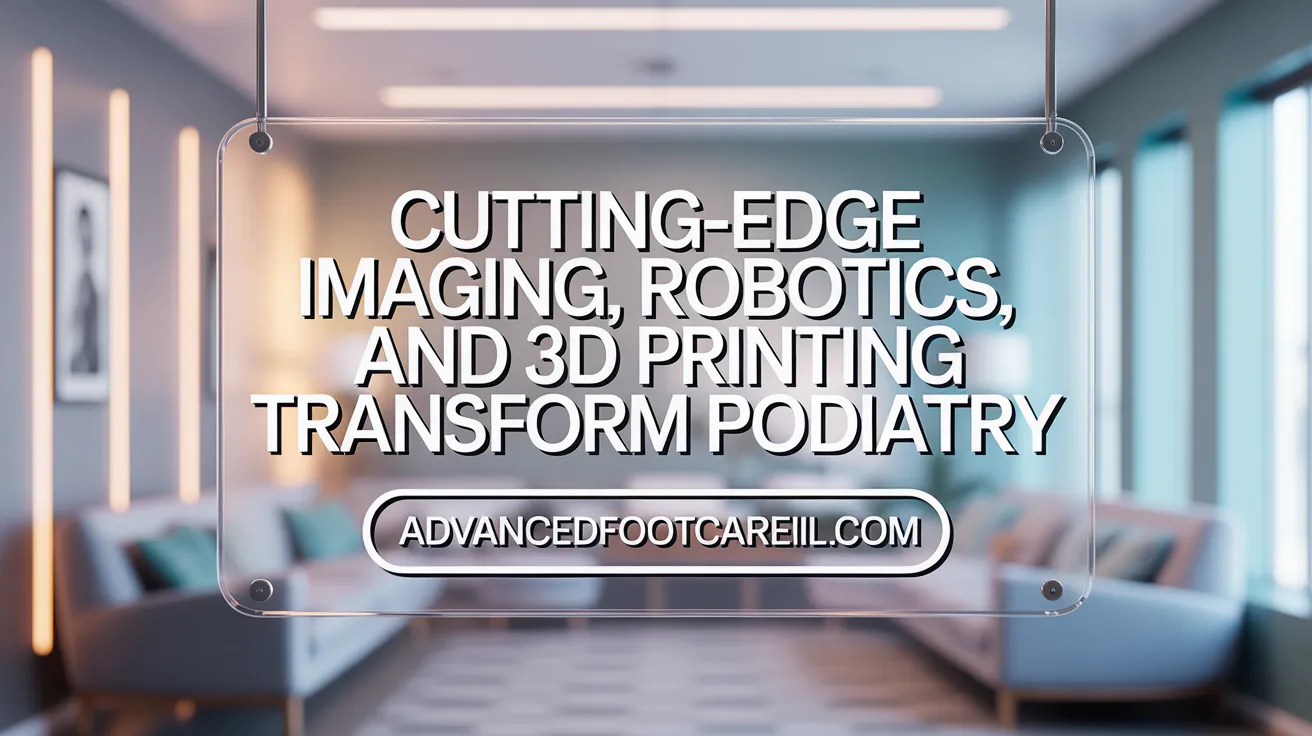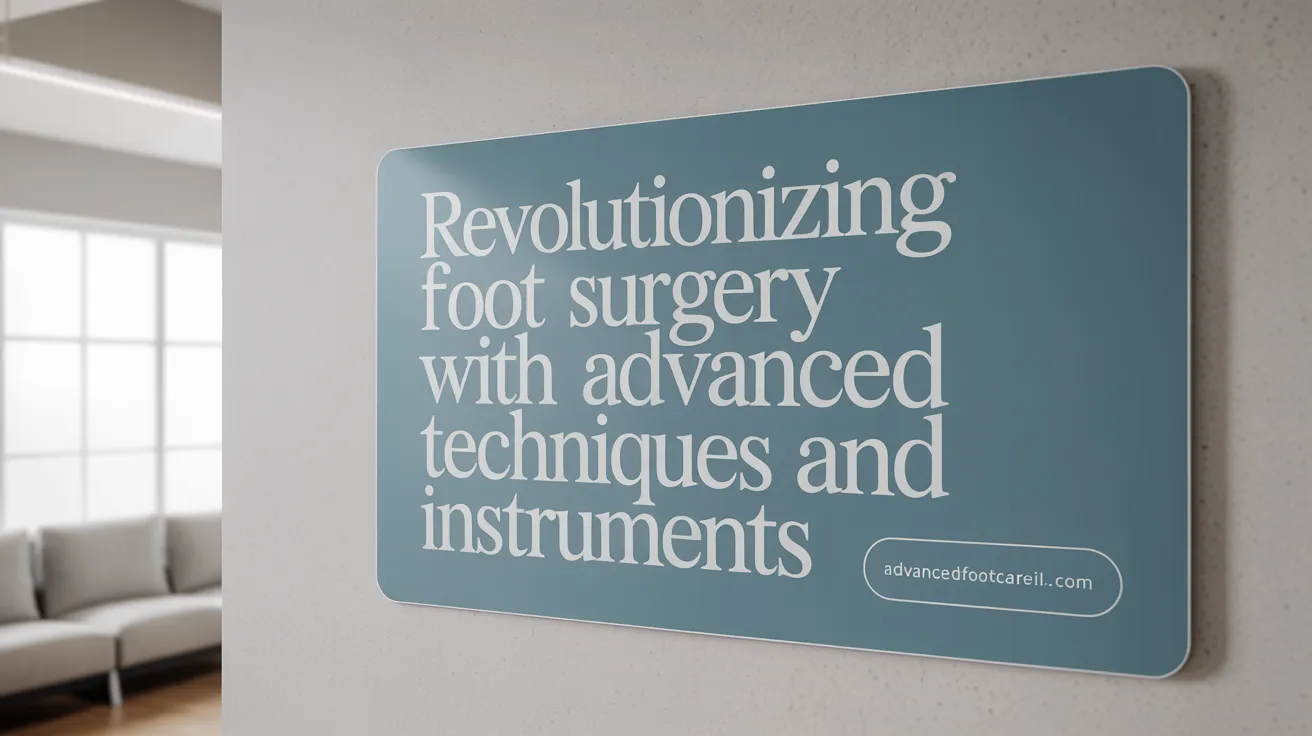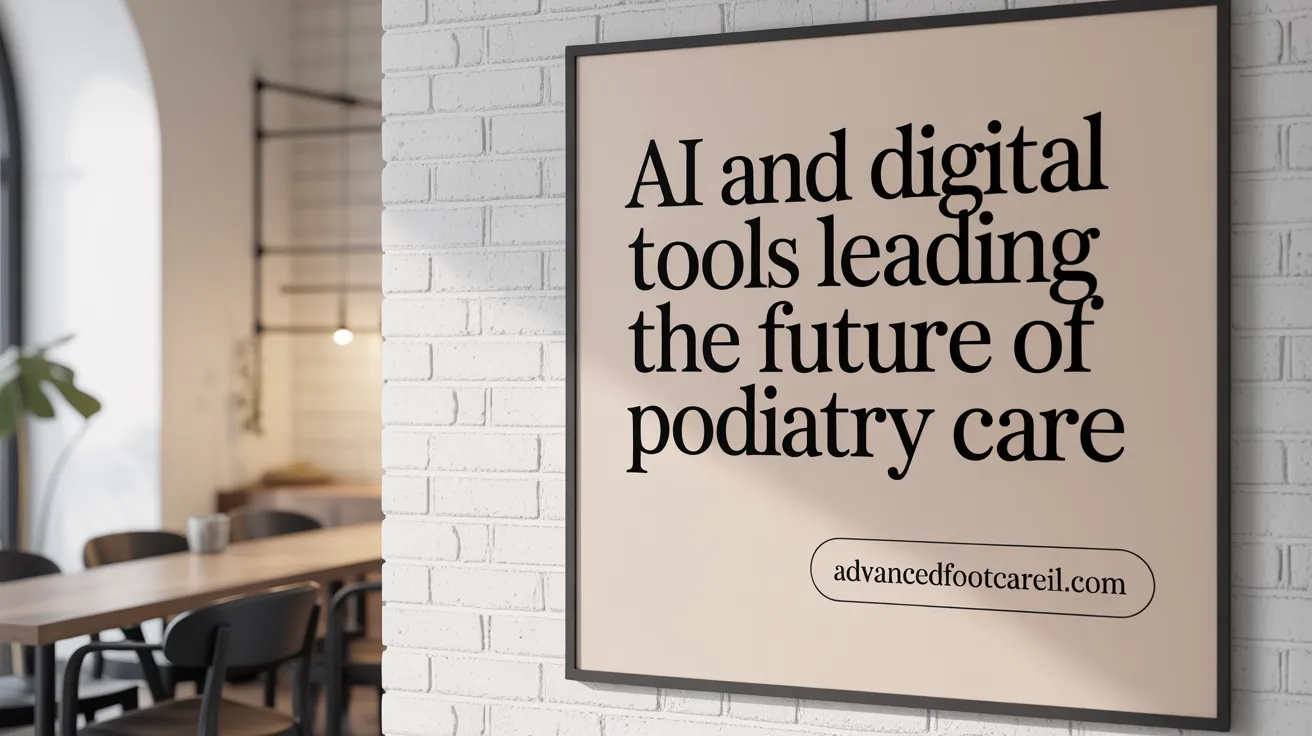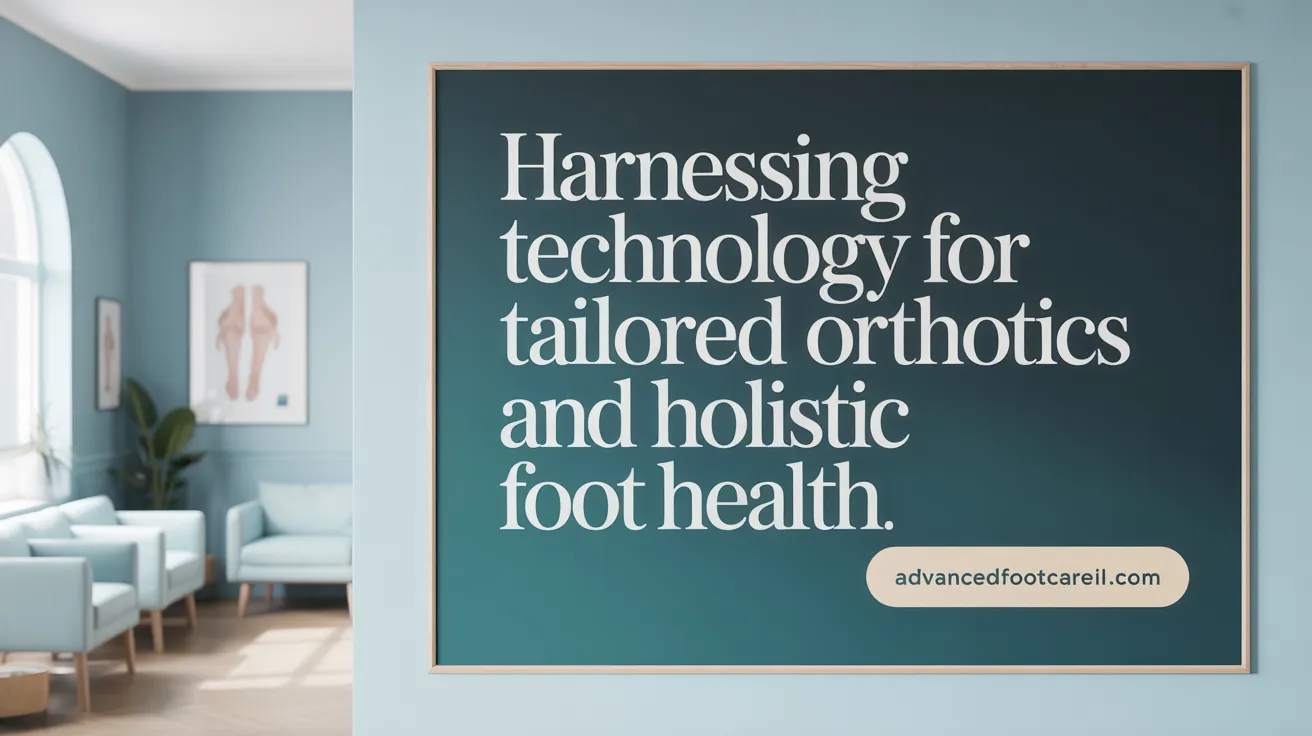The New Frontier in Podiatry
Minimally invasive podiatry is reshaping foot and ankle care by combining advanced technology with innovative surgical methods. This evolution promises less pain, faster recovery, and tailored treatments for a broad range of conditions, marking a transformative era in patient care that emphasizes precision, safety, and effective outcomes.
Understanding Minimally Invasive Foot Surgery: Precision and Patient Benefits

What is minimally invasive foot surgery and what conditions does it treat?
Minimally invasive foot surgery (MIS) involves performing surgical corrections through very small incisions, typically less than one centimeter. Surgeons use specialized instruments such as tiny burrs, endoscopes, and advanced imaging guidance like fluoroscopy to precisely treat various foot and ankle conditions. Commonly treated problems include bunions (hallux valgus), hammertoes, big toe arthritis, metatarsalgia, plantar fasciitis, Morton’s neuroma, and Achilles tendon injuries. This approach disrupts less tissue compared to traditional open surgery, aiming to correct deformities or relieve pain with minimal trauma.
What are the advantages and patient benefits of minimally invasive foot surgery?
MIS offers several significant benefits for patients that enhance recovery and comfort. The incisions are about 75% smaller than those in open surgeries, resulting in dramatically reduced scarring and lower risk of infection. Patients often experience less postoperative pain and swelling due to minimal tissue damage. Quick healing times enable earlier weight-bearing, with some patients returning to normal walking shoes within just a few weeks. Many procedures can be performed on an outpatient basis using local anesthesia, reducing hospital stays and associated costs. The improved cosmetic and functional outcomes translate into faster returns to daily life and work, making MIS an attractive option for suitable candidates.
Are all patients candidates for minimally invasive foot surgery?
While MIS is highly effective, it is not suitable for everyone. Ideal candidates typically have mild to moderate foot deformities that have not responded to conservative treatments like orthotics or physical therapy. Patients with severe deformities or complex foot conditions often require traditional open surgeries for better correction and stability. Additionally, MIS demands specialized surgical training as the smaller incisions limit direct visualization, requiring expertise to accurately interpret radiographic imaging during the procedure. Therefore, surgery should be performed by foot and ankle surgeons with advanced MIS training to ensure safe, reproducible results and optimal patient outcomes.
Technological Innovations Elevating Minimally Invasive Podiatry

How do modern imaging and technology enhance minimally invasive foot surgery?
Minimally invasive foot surgery (MIS) greatly benefits from cutting-edge imaging technologies that enhance accuracy and safety. Techniques such as fluoroscopy providing real-time X-ray guidance during surgery, ensuring precise bone cutting and screw placement through tiny incisions. Advanced imaging modalities including MRI and ultrasound offer detailed views of soft tissues and bones pre- and intra-operatively, improving diagnosis and surgical planning.
Additionally, 3D scanning offers detailed structural insight, enabling tailored surgical approaches that minimize tissue disruption. Robotics further elevate surgical precision by integrating features like force feedback and real-time navigation, helping surgeons perform complex corrections with enhanced control and reduced trauma. Artificial intelligence (AI) complements these advances by analyzing imaging data and patient histories to aid diagnosis, predict complications, and design personalized treatment protocols.
What role do 3D printing and digital scanning play in podiatry?
3D printing and digital scanning have revolutionized orthotic creation and customization in modern podiatry. Using precise 3D foot scans, podiatrists can digitally map the individual contours of a patient’s foot. This data is then used to 3D print custom orthotics crafted from durable, comfortable materials, improving foot alignment and comfort significantly compared to traditional methods.
The speed and accuracy of 3D printing allow faster production and iterative adjustments, enhancing patient satisfaction and clinical outcomes. Custom orthotics produced with this technology support biomechanical corrections and aid in treating various foot abnormalities as part of comprehensive treatment plans.
How are laser therapies and regenerative medicine integrated into foot care?
Laser therapy, such as the Remy Class IV Laser, offers a versatile, non-invasive modality for managing foot pain, inflammation, neuropathy, fungal infections, and wounds without the need for anesthesia. Its adjustable power settings allow targeted treatment, accelerating healing and reducing discomfort.
Regenerative medicine complements surgical techniques by using therapies like platelet-rich plasma (PRP) injections and shockwave therapy to stimulate natural tissue repair and reduce inflammation. These advanced treatments minimize the need for invasive surgeries and promote faster recovery, particularly for tendon injuries and chronic conditions.
Together, laser and regenerative therapies enhance the minimally invasive philosophy by providing adjunct treatments that improve patient outcomes and reduce recovery time.
Surgical Techniques and Tools Redefining Patient Outcomes

What are the latest surgical techniques involved in minimally invasive foot surgeries?
Recent innovations in minimally invasive foot surgery (MIS) include the use of percutaneous osteotomies performed through tiny incisions utilizing specialized low-speed, high-torque burrs with fluid irrigation to minimize heat and tissue damage. Procedures like the Minimally Invasive Chevron and Akin (MICA) technique combine these burrs with beveled, fully threaded screws that provide stable internal fixation, enhancing biomechanical stability.
Additionally, surgeons increasingly incorporate arthroscopic and endoscopic methods alongside fluoroscopic guidance to offer precise correction with minimal trauma. These advances allow for real-time imaging and navigation during surgery, enabling effective treatment of deformities such as hallux valgus and hammertoes without large incisions.
How is surgeon training evolving to support MIS success?
The technical demands of MIS require specialized education and hands-on experience. Surgeons must become adept at interpreting radiographic images during procedures where direct visualization is limited. To facilitate this, structured training programs include cadaveric labs and simulation exercises that build necessary tactile and imaging interpretation skills.
Industry leaders like Arthrex provide comprehensive educational resources, including surgical technique animations, detailed guides, videos, and live workshops. These tools support surgeons in mastering complex MIS approaches and maintaining up-to-date knowledge on instrumentation and evolving techniques.
What impact do these techniques have on patient outcomes and complication rates?
Minimally invasive surgical techniques offer significant benefits such as reduced blood loss, lower infection risk, minimal scarring, and shorter recovery periods. Patients often experience less postoperative pain and can often bear weight sooner compared to traditional open surgeries.
Despite these advantages, the complexity of MIS means that improper application or insufficient training can lead to complications including malunion, neurovascular injury, nonunion, or deformity recurrence. Rigorous patient selection and surgeon expertise are crucial to optimizing outcomes and minimizing risks.
Emerging developments continue to refine tools and methods, aiming for even greater precision, safety, and reproducibility in minimally invasive foot surgery.
| Topic | Advances & Details |
|---|---|
| Surgical Techniques | Percutaneous osteotomies, MICA fixation, arthroscopy, fluoroscopic guidance |
| Instrumentation | Low-speed burrs, beveled fully threaded screws, power units |
| Surgeon Training | Cadaver labs, radiographic interpretation, educational videos & guides |
| Patient Outcomes | Less blood loss, smaller scars, quicker recovery, fewer infections |
| Complications Management | Importance of expertise, proper case selection, ongoing training |
Integrating AI and Digital Tools to Revolutionize Diagnosis and Care

How is artificial intelligence transforming podiatry care?
Artificial intelligence (AI) is making a significant impact on podiatry by streamlining clinical documentation through voice transcription in podiatry, which improve efficiency and accuracy. AI enhances diagnostic precision by analyzing complex medical images, patient histories, and gait patterns. This allows early detection and prediction of complications such as diabetic foot ulcers. Moreover, AI supports clinicians in developing personalized treatment plans that adapt to individual patient needs. Financially, AI optimizes revenue cycle management, automating claims processing and reducing administrative overhead.
What digital tools support patient monitoring and engagement?
Smart shoes with sensor technology provide real-time data on gait, balance, and foot pressure points. This technology delivers immediate feedback, enabling better management of chronic foot conditions like plantar fasciitis and diabetes-related neuropathy. Additionally, mobile apps complement these devices by offering educational content and symptom tracking to boost patient engagement and self-care. Telemedicine for foot care platforms further enhance care by facilitating remote consultations and follow-ups, increasing accessibility especially for patients in rural or underserved areas.
How do digital assistants and agentic AI improve clinical workflows?
AI-powered digital assistants in podiatry automate routine tasks such as note-taking, schedule management, and billing, which reduces administrative workload for podiatrists. Agentic AI systems analyze imaging results like X-rays and MRIs with greater accuracy, identifying abnormalities that might be overlooked by humans. These tools integrate patient data with up-to-date clinical research to support informed decision-making and personalized care plans. By streamlining both clinical and operational processes, AI allows clinicians to focus more on patient care and improves overall practice efficiency.
Personalized Care through Custom Orthotics and Holistic Treatment Approaches

How are custom orthotics enhanced by modern technologies?
Custom orthotics have significantly benefited from advances in digital scanning, 3D printing, and software customization. Technologies like the Arkad digital customization software allow podiatrists to import precise foot measurements and design insoles that perfectly match each patient’s unique foot contours. This approach improves patient comfort and support by tailoring orthotics to exact anatomical needs. Additionally, these digital tools streamline manufacturing, boost clinical workflow efficiency, and enhance patient satisfaction through quicker turnaround and improved fit.
What holistic approaches complement minimally invasive podiatry?
Beyond surgery, holistic patient care plays a vital role in podiatry. Comprehensive education on foot hygiene, proper footwear selection, and lifestyle habits helps patients maintain foot health and prevents future problems. Supportive therapies such as laser therapy (e.g., Remy Class IV Laser), shockwave therapy, regenerative medicine injections (like PRP and amniotic fluid injections), and topical treatments including CBD creams assist in reducing pain, accelerating healing, and minimizing the need for surgical intervention. These integrative treatments foster a faster, less painful recovery and empower patients with active roles in their care.
Can you provide examples where technological advances have reshaped podiatry practice?
Several clinics have embraced technology to transform podiatry care. Rainier Foot and Ankle Associates employ Go 4D scanning technology for highly precise custom orthotics, which enhances diagnosis and support for better surgical outcomes. Telemedicine services have expanded access for remote patients, facilitating timely consultations and follow-ups without geographic constraints. In France, a podiatrist’s adoption of the Arkad software improved insole customization and operational efficiency, boosting patient engagement and appointment availability. These examples showcase how integrating cutting-edge technology optimizes personalized treatment and enhances the overall patient experience in modern podiatry.
A Leap Toward the Future of Foot Care
Minimally invasive podiatry marks a revolutionary shift in how foot and ankle conditions are diagnosed and treated. By harnessing cutting-edge surgical techniques, advanced imaging, AI-driven diagnostics, and personalized orthotic technologies, podiatrists deliver faster healing with less pain and fewer complications. The integration of holistic care models and digital tools further enhances patient outcomes and experience. As innovation continues to accelerate, minimally invasive podiatry stands at the forefront of compassionate, precise, and effective foot care — promising a brighter future for patients worldwide.
